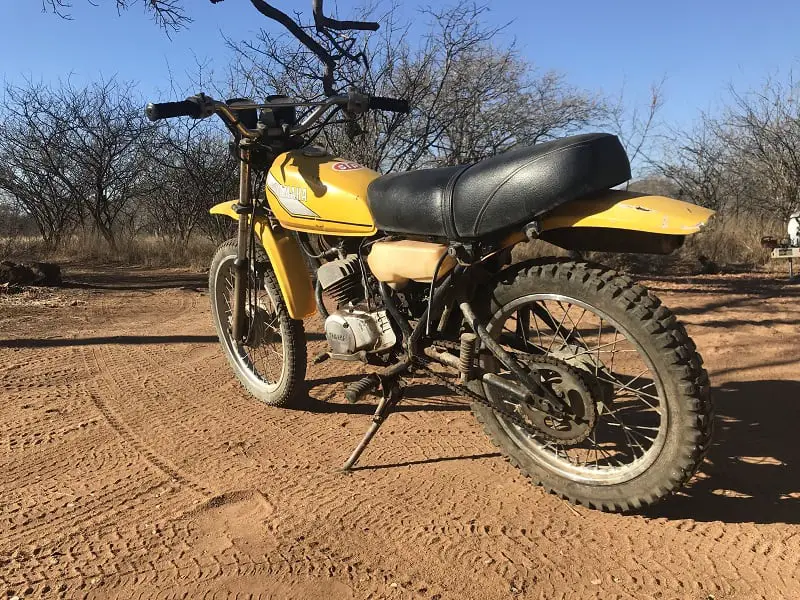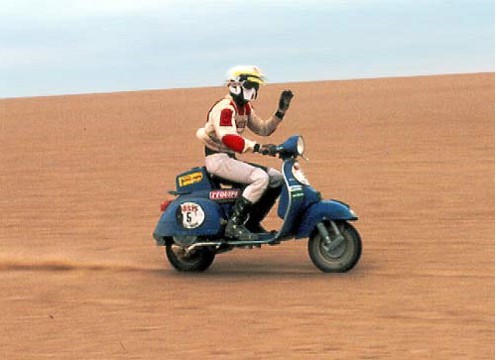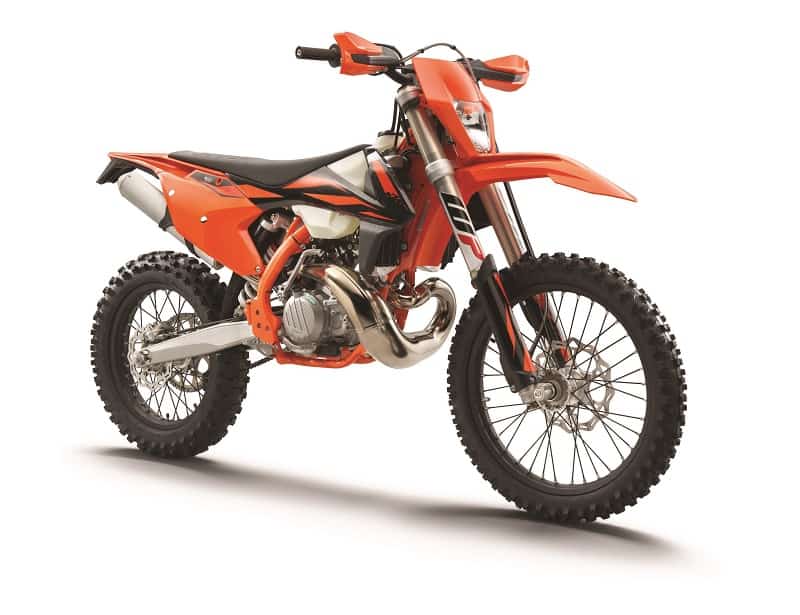I’ve got a old Yamaha 2-stroke dirt bike that my wife learned to ride on and I’ve often wondered how far I’d be able to tour on it. I mean, 2-strokes are made for blasting around in the dirt, not cruising at highway speeds for days. So I did some research and here’s what I’ve found.
You can tour long-distance on a 2-stroke motorcycle as long as you ensure it does not overheat. Many riders have done thousands of miles on 2-stroke motorcycles. However, 2-stroke motorcycles are not made for constant engine speeds and it may be difficult to find good quality 2-stroke oil at garages.
While I’ve read of quite a few riders who’ve done silly distances on their 2-stroke bikes, there are a lot of things you need to consider before strapping your backpack and sleeping bag on the back of your dirt bike and hitting the country roads. Provided that you managed to get your two-stroke motorcycle street legal and registered, the biggest concern is cooling.
You Can Tour Long-Distance on a 2-Stroke Motorcycle
If you are considering touring with a 2-stroke motorcycle, chances are that is it a very old classic street bike or it’s a dirt bike. Classics like the Yamaha RZ 350 can easily cruise at above the national speed limit, but parts are getting scarce and these bikes have been increasing in value. If you want to tour on it, you will need to make sure you take care of it.
Some dirt bikes, while geared for quick acceleration in the dirt, can easily exceed 100 mph. In many states it is possible to register your dirt bike to ride on public roads. You will have to fit a lighting kit like this one from Baja Designs and a speedometer like this digital unit from Trail Tech, both available on Amazon.
While the new KTM EXC bikes have radiators for liquid-cooling and electronically controlled oil pumps, most older 2-stroke don’t and as a result preventing the engine from overheating will be your biggest concern. If you vary the engine speed to pump excess fuel and oil into the cylinder and stop for a break to let the motor cool down every hour, there’s no reason why you can’t do long days in the saddle. That is, if your backside can last that long on the bench seat.
What are the Risks When Touring With a 2-Stroke Motorcycle?
Let’s be honest here. Two-stroke motorcycles are not designed for long-distance touring. A larger four-stroke will not only be more comfortable, but will be way more reliable than a 2-stroke motor if you plan on a cross country bike tour. Why is that?

Availability of 2-stroke oil
Due to emission regulations, 2-stroke engines have been phased out over the years and the only modern two-strokes available these days are competition dirt bikes and outboard boat engines. Not all garages stock good quality 2-stroke oil and you might have to carry your own if you plan on riding across country.
Two-stroke engines need a constant feed of fuel and 2-stroke oil to lubricate the pistons and cool the engine. Running with fuel only will very quickly heat up the piston and cylinder and result in a seized engine.
Two-strokes don’t like constant throttle openings
Most 2-stroke motorcycles are designed to be raced or to blast around a motocross track where the frequent acceleration results in excess fuel and oil to lube and cool the motor. These engines don’t like constant, lower RPMs where the engine might be starved of cooling oil.
If the engine is not cooled properly, the piston may expand faster than the cylinder bore and result in a seized engine due to excessive friction.
High fuel consumption
A 2-stroke motorcycle will be much less economical than a 4-stroke with equal performance. Many two-stroke bikes also have small fuel tanks, as they were not designed to go very far. This will make your trip more expensive and you will need to carry extra fuel. If you do need to carry extra fuel on your bike, check out my other post on how to do so safely.
Two-stroke engines require frequent maintenance
Competition dirt bikes are designed for high performance, not long-term reliability. It is not uncommon to replace piston rings after only 20 hours of riding, and a top-end rebuild after 50 hours. While this can be extended if you don’t race flat-out, even doubling the time to the next rebuild by taking it easy may mean an engine overhaul every week on a long trip.
Apart from serious rebuilds, 2-stroke’s can also foul up spark plugs quickly, which means you may need to clean or replace the plugs regularly to keep the engine firing properly.
Vibration and uncomfortable seats
Two-stroke motorcycles generally don’t have counter balancing shafts and vibrate a whole lot more than 4-strokes. Combine this with a very uncomfortable bench seat design so you can slide around on it for jumps and slides in the dirt, and the unreliable engine may just outlast your backside.
These Guys Have Done Thousands of Miles on 2-Stroke Motorcycles
Okay, so it is a bad idea to tour long-distance on a 2-stroke motorcycle. But has it been done? Absolutely!
In 1980, M. Simonot and B. Tcherniawsky ‘competed’ in the grueling Paris-Dakar Rally on Vespa PX 200’s. They were among the 81 finishers of a race through 7 countries and over nearly 10 000 km (211 vehicles started the rally). They had a back-up team in Land Rovers, but so does all the other racers. If this is possible on a 2-stroke scooter, then a tour on some back-roads on a dirt bike can’t be impossible.

Kevin Gundestrup did 30 000 miles on his 1975 air-cooled 3-cylinder Suzuki GT 550 with a sidecar. He’s advice? Use the correct premix (32:1), don’t let the oil pump reservoir go dry, and make sure your ignition timing is set correctly. Also, don’t ride with the throttle wide open. Instead, gear the bike correctly with a larger sprocket up front. Kevin further suggested carrying a correctly gapped spare spark plug with the correct heat range.
In 2013, four guys on LML 2-stroke scooters left South Africa for Ireland. They covered nearly 30 000 km through Africa. I remember chatting to Christopher Venter before their trip as we did a similar trip two years before them, but on 4-stroke 200 cc Chinese delivery bikes. He later became known as The Blind Scooter Guy after contracting an illness on the trip that cost him his eyesight.
What Specific Maintenance is Required on a 2-Stroke?
If you do plan on a long-distance ride on your 2-stroke, make sure your engine is in good condition. If you are concerned about the condition of the piston rings and the cylinder bore, rather have it it rebuilt before you leave.
Some riders suggest using NGK Iridium spark plugs, as they don’t foul up as easily, and good quality 2-stroke oil. You might need to carry your own, as it may not be freely available at gas stations. If your bike has contact breaker ignition, like most older bikes, check the timing every 1 000 miles and keep the breaker points cam lubed with a small smear of grease.
Are 2-stroke Motorcycles Dead?
Emission laws have become stricter over the last few decades and car and bike manufacturers have been adapting technology to stay compliant. The result? Only a handful of 2-stroke motorcycles remain.
Some manufacturers have evolved their 2-stroke machines to include electronic CDI ignition and liquid-cooling. Examples are the KTM 300 EXC TPI and the Yamaha YZ 250 motocross bikes. While the YZ still runs a carburetor, the KTM now has fuel injection too.

This ensures compliance with emission standards, but also make these bikes more reliable due to more accurate air/fuel ratios and ignition timing, as well as more efficient cooling.
Conclusion
If you are really set on touring long-distance on your 2-stroke dirt bike or your old classic oil-burning street bike, it is totally possible. Just make sure you understand the limitations. Look after your bike and know that you are in for an adventure, rather than a trouble-free bike cruise.
On the other hand, if you are considering using your 2-stroke bike for a long trip because of budget constraints, just get a cheap 4-stroke. You will have much less worries and will enjoy the trip that much more, knowing that if something does go wrong, it is likely not going to break the bank.
For more reasons why I think you’re better off touring on a small 4-stroke, read my post on the insights I gained during a 3-month trip through Africa on 200 cc Chinese road bikes. You can find the article HERE.
